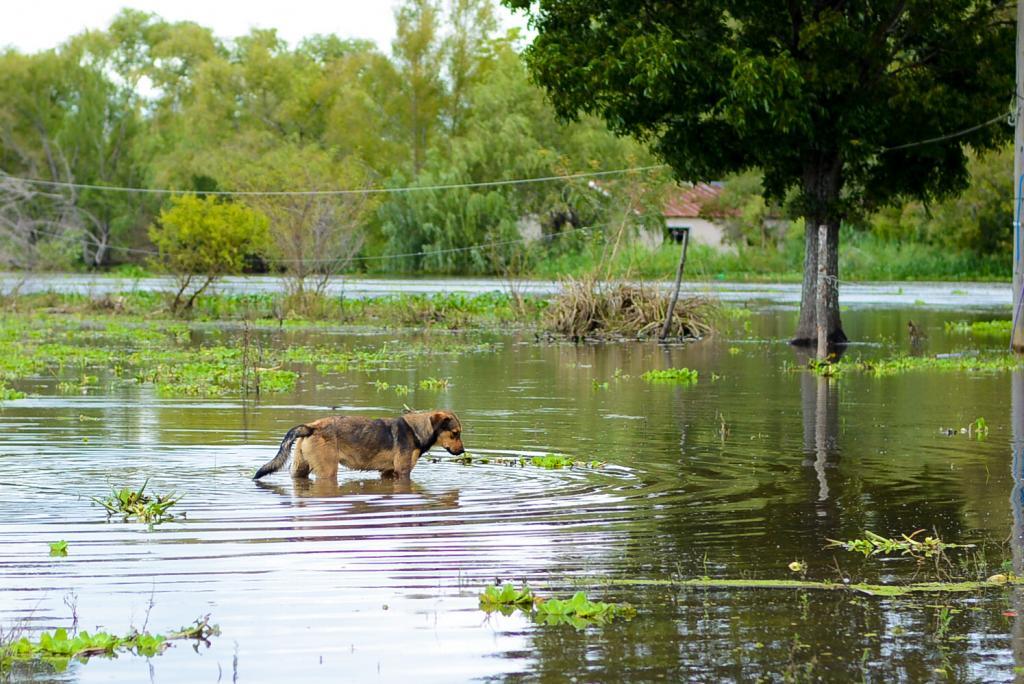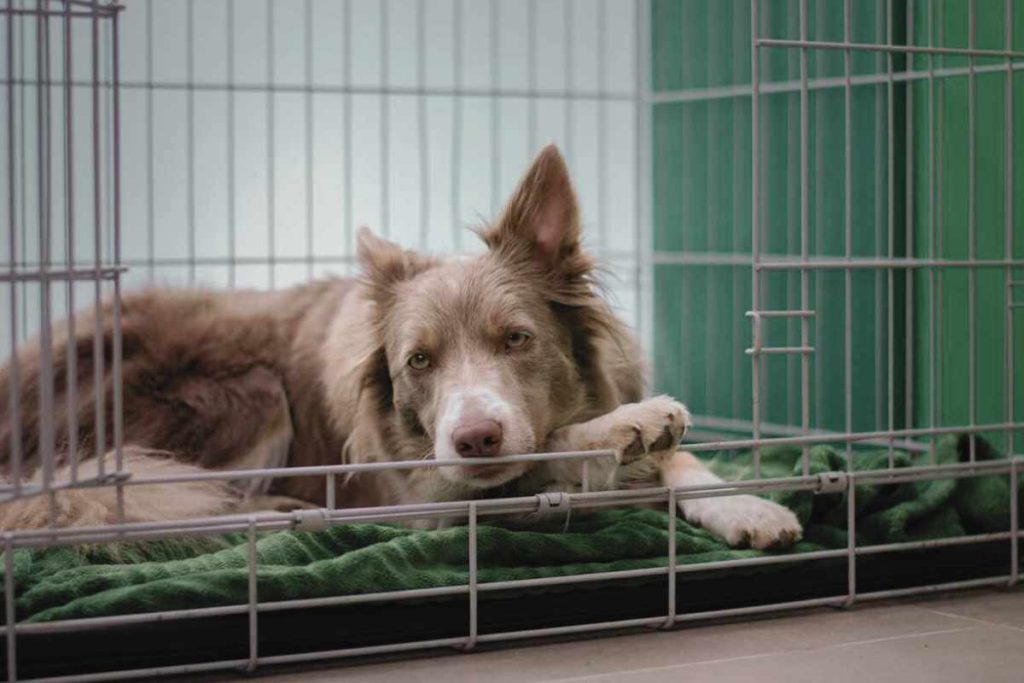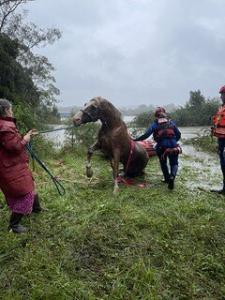

Estimated reading time: 1 minute
NSW flood emergency: updated Friday, 23 May 2025
A flood emergency continues to unfold across New South Wales, with three people dead and tens of thousands of residents forced to evacuate. The severe weather is also posing serious risks to pets, livestock, and wildlife, prompting animal welfare organisations to issue urgent pleas for pet owners to include animals in all evacuation plans.
A significant number of pets and farm animals in flood-affected areas such as Taree, Port Macquarie, and Coffs Harbour are reported to be either stranded or lost in the deluge. Farmers have reported heartbreaking losses, with entire herds drowned and properties destroyed.
The Port Macquarie Koala Hospital, a critical care centre for one of the state’s most beloved species, has temporarily closed due to the ongoing flooding.
“There is still significant flooding in our region, so we have made the decision to stay closed for this morning and reassess conditions during the day.
“The safety of our koalas, team, and visitors is paramount. Our hearts go out to our beautiful community.
“We know how everyone pulls together and supports each other during these incredibly devastating times. And this time will be no different.”
The hospital has issued a 24/7 emergency contact for flood-affected koalas: 6584 1522. For other native animals, contact FAWNA on 6581 4141.
Found injured wildlife? Here
WIRES and other wildlife rescue services are also on high alert, responding to calls for injured or displaced animals.
If you find a wild animal in distress:
- Do not approach unless safe.
- Place it in a ventilated box lined with a towel or blanket.
- Keep it in a quiet, warm location.
- Contact the appropriate rescue hotline.
Essential Animal Emergency Contacts
- NSW SES: 132 500 (flood/storm emergencies)
- WIRES: 1300 094 737 (wildlife rescue)
- RSPCA NSW: 1300 278 358 (general animal welfare)
- Port Macquarie Koala Hospital: 6584 1522
- FAWNA (Mid North Coast): 6581 4141
This article will be updated as new information becomes available.
Including animals in your emergency evacuation plan: prepare for your pets, too
As the devastating floods and bushfires that have ravaged Australia in recent years have reminded us, emergency situations can unfortunately happen at any time.
And when they do, pet and livestock owners are often left in a state of panic and uncertainty.
As we’ve seen time and time again, animals are often the largest causality of these disasters.
While wildlife is usually the most affected, it’s crucial to have a well-thought-out evacuation plan in place to ensure the safety and wellbeing of pets and livestock during such emergencies.
In this guide, we will discuss key tips and points for pet owners and farmers on preparing for and handling natural disasters, including floods and bushfires, and what essentials should be included in a disaster kit.
Pets are an integral part of our families. That sentiment has been on display countless times in recent years during Australia’s weather emergencies.
When natural disasters – storms, floods, or bushfires – strike, our pet’s wellbeing is often as concerning to us as that of any other family member.
The country has experienced devastating weather emergencies and natural disasters in recent years, with bushfires, storms, and floods leading to significant loss of live, homes, and livelihoods.
And, as a result, countless animals were killed after families were forced to flee their homes with little to no warning, leaving their pets behind.
Sadly, many of the farm animals that were left to fend for themselves ended up drowning.
However, pets have specific needs that are crucial to address, especially when dealing with the unpredictability of natural disasters like floods and bushfires.
With the Bureau of Meterology warning for more severe thunderstorms across parts of Australia, it’s crucial pet owners have a plan in place that includes their animals, in case of an emergency.


Preparing animals for natural disasters
Pet owners are encouraged to have a disaster plan that includes their pets in place in case of an emergency.
Simple things like having an emergency pet kit ready can make the difference in a life-threatening situation.
“It’s crucial to have a plan for your animals before disaster strikes,” said Ben Pearson, country director for World Animal Protection.
“While there is an outpouring of compassion for animals, many people are unaware of how to help them.
“Without a plan, people may make panicked decisions that threaten the safety of their animals and their family.


What to pack for your pets in an emergency
In severe weather conditions, it’s important to be well-stocked and prepared in case you get evacuated or are cut off from electricity and water.
You don’t want the added stress of trying to remember your pets’ essential items, and possibly risking the chance of being able to take them with you. Or not having access to enough food for them at home.
Here’s a list of pet care items that are good to keep together and easily accessed in case of an emergency.
FOOD: At least three days’ worth of non-perishable food.
WATER: At least three days’ worth.
MEDICINE: Store in a waterproof container.
VET RECORDS: Keep copies in a watertight container.
FIRST AID KIT: Extra cotton bandage rolls, bandage tapes, scissors, tweezers, and latex gloves.
BLANKET & BEDDING: Familiar items to reduce stress.
SANITATION: Newspapers, paper towels, plastic bags, gloves, and household bleach for cleaning.
Pet identification and equipment essentials
- Collar or tag with your and your pet’s details.
- Register and microchip your pet.
- Store a current photograph of your pet in a waterproof container.
- Sturdy lead, harness, or muzzle.
- Cages or carriers for safe transport.


How to help pets and livestock after a bushfire or flood disaster
Planning for disaster is vital, but it’s also important to have a plan to help animals recover after an event.
World Animal Protection’s tips to help transition animals back to normality
- Clean water sources: dams or ponds that your pets drink from might be contaminated, so try to avoid them drinking or going into them.
- Clear hazards on your property so that debris has gone before moving your pets back in.
- Create a calm environment with their favourite toys and blankets to reduce stress.
- Monitor your pets for any injuries they may have sustained, and contact a vet if you are worried about an injury or their behaviour.
- Re-stock your disaster planning kit, if you don’t already have one, you can download your plan today.
- Review and improve your disaster plan!
- Update or replace their ID tag if details to have most recent details.
Heartwarming animal rescues from Australian flood disasters
Many heartwarming stories of people rescuing and caring for animals in floods have emerged from the devastation.
MP for the Animal Justice Party, Mark Pearson, says it’s great to see how much the community cares for animals.
“We’ve seen Australians go above and beyond for animals by saving pets, farmed animals, and wild animals alike,” Pearson says.
Pearson says it’s also great to see people caring for farm animals just as much as pets like cats and dogs.
“I saw a government document about the floods referring to animals and livestock separately,” says Pearson.
“Most Australians don’t see a distinction, and don’t consider livestock as just objects or stock to be lost.”


“All animals suffer in natural disasters, just like humans, and we as a society are really starting to realise that,” Pearson says.
“It’s inspiring to see so many incredible stories of people rescuing not only dogs and cats, but koalas, kangaroos, horses and cows.
“I thank the volunteers working to save lives, but I want to remind the public to never put themselves in danger.”


Mark calls on Australians to have a plan in place for caring for their animals in a disaster.
“This is a good reminder for everyone to have a plan of action in place for saving the animals in your care.”

